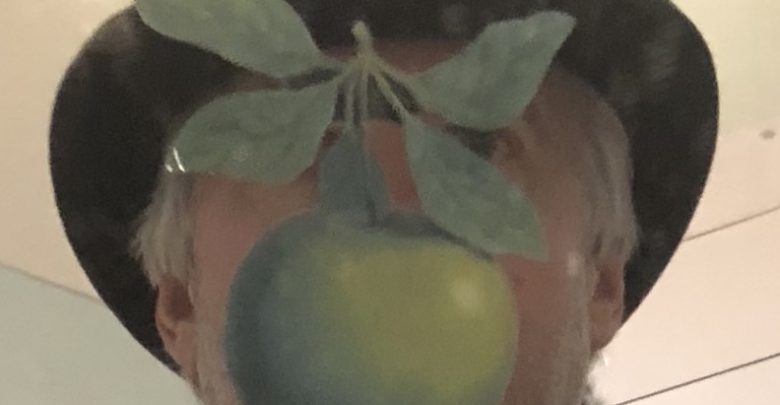A Giraffe in a Glass
About half way through the Magritte exhibition at the San Francisco Museum of Modern Art, a teenage girl grabbed her mother by the arm and steered her to a painting that obviously delighted her.
“Oh look! A giraffe in a glass!”

I hadn’t given the giraffe (or, I should say, the painting of a giraffe – after all, this is not a giraffe) more than a passing glance. To me, it had been just one of Magritte’s many clever, surprising images on display. A lesser one, at that.
I had walked right by it, on my way to more interesting (to me) images like anonymous bowler men
.
cityscapes in which it was both day and night at the same time

seemingly transparent paintings-within-paintings that obliterated the distinction between the image and the thing itself

and seagulls who carried their own daylight into the night sky.

There’s something to be said about seeing a surprising image (or anything else) with fresh eyes for the first time. I remember the first time I saw that Claes Oldenburg had transformed Picasso’s gargantuan Chicago outdoor sculpture (a prehistoric bird? a cross between a woman and an Afghan hound?) into a cufflink. I bought a $2 poster of it, framed it, and put it on my wall.

The idea of turning a monument into an everyday object isn’t unique to Oldenburg. My grade-school classmate, Donald Lipski, does much the same thing in reverse, juxtaposing everyday objects in unexpected ways, and then turning them into monuments. The first time I saw one of Don’s works of public art on the southern edge of Central Park, an enormous red chair with a horse standing on the seat, I had no idea it was his. I just knew I enjoyed walking by it on my way to work.
(Don drew a picture of an atom bomb on the cover of my seventh-grade science report. I think it was about Bolivia, complete with annual rainfall totals, cribbed from the Encyclopedia Britannica. I have no explanation for why I had a picture of an atom bomb on the cover. I wish I still had it – the cover that is, not the report. I’m sure my mother threw it out the minute I left home, along with my baseball cards and comic books.)
There’s even a famous poem about seeing a work of art for the first time, “On First Looking into Chapman’s Homer” by John Keats. After assuring us that he is no naif, and that he has seen more than his fair share of the world’s wonders (“realms of gold” and “goodly states and kingdoms”), Keats throws off his posture of jaded cool to describe his reaction to first hearing Homer’s actual words. He felt, he says, like a sky-watcher “when a new planet swims into his ken,” or like the explorer Cortez when he first glimpsed the Pacific Ocean. (If you know anybody who has that kind of reaction to a translation of Homer, you might recommend professional help. But that’s another story.)
The work of art in question for Keats was a translation of The Iliad, not a painting, but in previous centuries written works were inaccessible to anybody who didn’t happen to speak the language of the author, ancient Greek in this case. Translation made those works accessible to those who spoke different languages, just as museum exhibits, photography, and the internet today make paintings accessible to millions who otherwise would never travel to Italy, France, or wherever a particular painting might be located.
Having instantaneous, universal access to images of art works changes how we see the original work itself. Does anybody these days really see the Mona Lisa or the Sistine Chapel for the first time? Familiarity may not breed contempt, but it breeds, well, familiarity. There’s an “observer effect” in art, just as there is in physics.
The image itself may not change, but its observers do. Popularization of the image turns unique works of art into everyday objects, much like Oldenburg turned a monumental Picasso sculpture into a cufflink. Seeing the real thing after having been saturated with the image turns a familiar image into a work of art, just as Donald Lipski turns familiar objects into works of art, whether it’s his horse on a chair, or a house-sized Dalmation balancing a yellow cab on its nose.

These days, we cannot only see the works of great artists, we can put ourselves in them. No genetic good fortune, training, or agonizing years of lying on a scaffold is required. All we need is maybe 30 seconds and a cell phone.
Meet Janet and Philip by Rene Magritte (sort of):





I enjoyed this. Made me laugh. Good for you to get away from Trump disasters for a while too.
I’m pretty sure you have wall space for the (sort of) Rene Magrittes in your new home.
I’m sorry your Mom threw out your comics and baseball cards????
Yes, very sad. But I forgave her. She was, after all, my mom.
Ahhh, Magritte must have been having a “Sun-downer” , ie enjoying a glass at sunset in the midst of a game-drive, one of my favorite past-times in Africa. I really enjoyed this light essay, Philip, and thank you for it. It also reminded me that Oldenburg did this exchange in both directions; he also turned the humble lipstick.into a monumental sculpture, as you well know.
SKD
Nice and funny and very much needed break from Trump. Enjoyed reading it.
Like your mom, I am afraid I might have done some damage as well, without really knowing. Maybe like your mom !?
Lots of fun Philip! Seeing the origins of images we have come to know is like going home to Mom… even if she did purge that place of our prized possessions! Thanks for the romp.
Lee